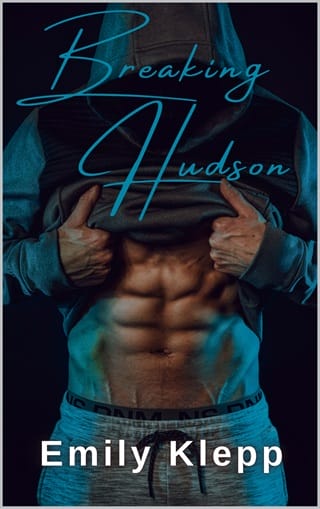Chapter 5
CHAPTER 5
Posey
T he Crown Velocity headquarters is equally impressive when I pull up today in my rental vehicle. It was a bit easier navigating out of London to Woking and I’m more confident in driving on the opposite side of the road, but I’m resolved today to find an Airbnb around here.
The skies are dark and overcast and it’s downright cold. The threat of rain feels like it’s seeping into my bones. As a born and raised Southerner, I don’t take well to the cold and today I bundled up in my big puffer coat with a hat, mittens and a scarf.
Yes, I know it’s only forty-six degrees Fahrenheit—or eight degrees Celsius, as my car temperature registered—but that’s frigid to me.
The massive glass and steel building looks even more imposing with the dark clouds swirling above. I hurry into the lobby to find Lex is already there, looking every bit the impatient driver. Of course, I can’t help but notice how unbelievably gorgeous he is, especially with a few days’ stubble and his hair tousled like he just rolled out of bed. He’s dressed in clothes that scream luxury and yet effortless style—a tailored wool overcoat in charcoal gray, a cashmere crewneck sweater in a lighter gray and black slim-fit jeans. The Chelsea boots in black leather complete the ensemble and I feel dowdy and unsophisticated in my forest-green parka with faded jeans and a fuzzy baby pink sweater underneath, although I take some level of pride in my silver sparkle tennis shoes because they make me smile.
“You’re late,” he says drolly, though there’s a hint of amusement in his voice.
“Am I?” I stammer, feeling slightly intimidated by the confident race car driver standing before me and not the drunken fool I saw last night. “I thought I was right on time.”
He starts walking, and I scurry to keep up, mentally kicking myself for being a bit frazzled. “Close enough,” he says with a smile. “We’ve got a meeting with the engineers in five minutes so I hope you have lots of questions ready.”
My head is already buzzing with a thousand things I’d like to ask, but I don’t want to sound like a complete idiot. “So, um… can I ask a few questions before we go in?” I venture cautiously.
Lex raises an eyebrow but doesn’t stop walking. “Go on.”
“What does ‘formula’ even mean? Like in Formula International?”
He does a double take, as if he can’t believe I’d ask such a thing. “You don’t know?”
“Well, I have a rough idea, but I want to make sure I get it right.” I cringe, hoping I don’t sound as clueless as I feel. While I know a lot about the drivers and teams from watching the documentary, there are still so many small details I’m light on.
“All right,” he says, slowing his pace enough to explain. “It refers to the set of rules that all teams must follow. In other words, the formula. Everything from the car’s design to the engines to the amount of fuel we can use during a race is regulated by the governing body—so all the teams are competing on a level playing field.”
I nod, furiously scribbling in my notepad as we walk, hoping I don’t trip and fall on my face. “So, the cars aren’t all that different?”
“They’re different in some ways, but the differences are within strict limits. Aerodynamics, engine performance, tire management—those are the key areas where teams try to gain an edge, but we all work within the same formula.”
“Got it,” I say, but more questions spin from this initial information. “And how did you get into all this? I read that a lot of drivers start in karting but I’m not sure what that means.”
Lex nods, seeming a bit more relaxed now. “Yeah, I began in karting when I was five. It’s where you start if you want to be an FI driver—learning the basics, developing race craft, getting a feel for the speed.”
“And… it’s just a go-kart you drive around a track?” I ask, scribbling notes.
Eyes twinkling, he says, “It’s definitely a kart you drive around a track, but they’re a lot faster than what you Yanks typically think of. They’re designed for racing, not for Sunday picnics in the park.”
“Noted,” I mutter, writing down that exact line.
“From karting, I did a brief stint in the Crown Velocity driver’s academy before moving into Formula International 3, or FI3. That’s a development series and the first level of professional single-seater, open-wheel design racing. That’s where—”
“Wait… hold up,” I say, stopping in place to continue jotting notes. I glance up at him. “What do you mean single-seater, open wheel?”
To his credit, Lex doesn’t roll his eyes or make me feel stupid. “Open wheel just means the wheels aren’t enclosed by bodywork the way they are in, say, stock car racing.”
“And that’s important to the sport because…”
“Because coupled with the single-seat design, it centers the central cockpit around the driver for maximum aerodynamic efficiency, which is something you’ll learn more about in the meeting we’re headed to. These cars rely on aerodynamics to generate downforce, which keeps the cars stable at high speeds.”
“Which get up to two hundred miles per hour,” I chirp, showcasing some of the stuff I learned already.
“ Over two hundred and thirty miles per hour.”
Laughing, I shake my head and tap on my notepad. “Back to the levels of racing. You said you went from karting to an academy to FI3.”
“Yeah, but let’s keep walking so I’m not late.” Lex continues, weaving us through the building. “FI3 is the first professional series you enter. All the cars have the same chassis and engine and there’s a limit to the horsepower. This phase of racing is for driver development—race craft, control, strategy—and for the chance to move upward to FI2.”
“Assume faster cars?” I muse as I scribble.
“More horsepower, but the teams all still have the same chassis and engine so the playing field is more level. Again, it’s to develop driver skill. And the best of those advance to the FI level, which is the pinnacle.”
“Where you design your own vehicles,” I say. It’s all coming together now.
“This level has the fastest, most technologically advanced cars the world’s engineers can create. We’re driving thousand-horsepower engines compared to only three hundred and eighty at the junior level. This is where you hope all that race craft and control you learned prior keeps you from getting smeared across the track at two hundred and thirty miles per hour.”
I swallow hard, suddenly understanding how elite you have to be to compete at Lex’s level. “It’s admirable that you’re here at only twenty-four years old.”
Lex chuckles and holds open a door for me to enter before him. “I guess. But when you consider I started at age five, it’s been a long journey. I won the FI2 Championship when I was nineteen and got called up to FI the following year.”
“Wow.” I am completely impressed. “So you’ve been in FI since you were… twenty?”
“Yep,” he says. “One of the youngest drivers to win a podium in FI too.”
Before I can respond, we reach a large door and he pushes it open, gesturing for me to go ahead. I step into the room, and it’s like stepping into another world. A long conference table is surrounded by engineers, each of them with laptops open, screens glowing with what I can only assume is important data. Three large flat-screens are on the wall, each showcasing charts and graphs that look like another language. I don’t understand how I’ll ask a single coherent question here today.
“Morning,” Lex says. “I’m sure you all got the memo from Harley, but this is Posey Evans. She’s a reporter writing an article on Crown Velocity and she’s going to be shadowing me through the first race. I thought she could learn some engineering today. Maybe you could each tell her what it is you do here at Crown Velocity.”
I feel every eye in the room on me. My notepad feels tiny in my hands compared to the serious machinery in front of them.
Lex starts with the introductions. “All right, Posey. These are the people who actually make the magic happen.” He points to a man at the head of the table with salt-and-pepper hair. “That’s Giovanni Scava, our aerodynamics engineer.”
Giovanni nods politely, pushes his glasses up his nose and speaks in a deep Italian accent. “My primary responsibility is optimizing the aerodynamic coefficients of the chassis, ensuring the laminar flow adheres to the bodywork with minimal boundary layer separation. We manipulate the airflow vector fields to maximize downforce while minimizing parasitic drag, particularly in high-speed straights and corner apexes. In addition—”
Lex holds up his hands. “Gio… mate… let’s dumb that down a bit. You’re making my eyes cross.”
There’s chuckling around the room and Giovanni mutters an apology. “ Scusi . In simple terms, I’m in charge of making sure the car slices through the air as efficiently as possible. Downforce, drag, airflow—all of that determines how fast we can go and how stable the car feels in high-speed corners.”
I scribble down every word, even though I only half understand it. I’m determined to figure it out later.
Lex moves on to the next person, a woman in her early thirties with sharp eyes and short-cropped hair. “This is Emma Dunne, our mechanical engineer. She handles the suspension and chassis.”
Emma smiles warmly as she explains in a light, British accent, “I work on making sure the car’s setup is perfect for each track. That includes the suspension, the ride height, and the balance of the car—everything that makes sure Lex is comfortable in the cockpit and can push the car to its limits.”
I nod, still writing, though the words are blurring together.
Next, Lex gestures to a bald man with a blond goatee. “This is Thierry Dubois, our power unit engineer.”
Thierry gives a curt nod before speaking and as expected by his name, his accent is French. “I focus on the engine and hybrid systems. It’s my job to make sure the power unit is delivering maximum performance while staying within the limits of fuel and energy usage.”
I’m barely keeping up. The sheer complexity of it all is overwhelming, but I keep taking notes, determined not to miss anything.
Lex moves to the next person, a tall blond woman. “Anya Weber, our tires engineer, all the way from South Africa.”
Anya smiles, her accent lilting and cultured. “I handle tire strategy—everything from tire compound selection to managing wear during the race. Tire performance is key to winning races.”
Tires. Finally, something I understand. I jot down her explanation and smile at her gratefully.
“And last but never least,” Lex says, pointing to a serious-looking man, “this is Gareth Elrod, our strategy engineer. He’s a Yank like you.”
Gareth nods, tips a slight salute to me with two fingers. “Straight from the great state of California, I’m responsible for race simulations, pit stop strategies and making sure we optimize everything to get the best result on race day. Some might say I’m the most important engineer.”
He flashes a mischievous smile and there’s good-natured grumbling around the table. Someone throws a wadded piece of paper that bounces off his head, and it puts me more at ease. I’m in a room full of major brainpower but that little joke reminds me… they’re just people.
And then it hits me—a group of multi-national experts showcasing just how international this sport is.
Still, my head spins from information overload, but I manage to smile and thank everyone.
The meeting begins, and I try my best to follow along as Lex dives into a discussion about the simulator run he did yesterday. He mentions something about “oversteer in the fast corners,” and Giovanni immediately asks for details.
“Turns three and eight,” Lex says. “It’s manageable, but I had to countersteer more than usual. It feels like the rear isn’t planted.”
“Sorry,” I interrupt, feeling a little sheepish. “What’s oversteer?”
Lex grins, clearly happy to explain. “Oversteer is when the rear of the car loses grip before the front does, so it feels like the back end is trying to overtake the front. Makes the car more likely to spin out, especially in fast corners.”
“Oh,” I say, nodding like that makes sense, though I’m still not sure I fully grasp it.
“And understeer,” Emma adds, “is the opposite. When the front of the car loses grip and you can’t turn as sharply as you want to.”
I write down the terms, feeling a little more enlightened.
The meeting continues with the engineers discussing adjustments to the rear wing angle, tire pressure and energy deployment strategies. It’s all so technical, and I’m blown away by how much science and engineering goes into every decision. This isn’t just driving fast—it’s a finely tuned operation where every millimeter, every gram, every second counts.
By the time the meeting wraps, I’m exhausted from trying to absorb it all, but I feel a strange sense of accomplishment. I’m starting to get it—just a little. As we walk back toward the lobby, I can’t help but shake my head. “That was… so technical. I had no idea how scientific this all is.”
Lex chuckles, clearly enjoying my reaction. “That’s Formula International. Everything has to be perfect. Every adjustment, every tweak—it’s all about shaving off fractions of a second.”
“And you…” I glance up at him, feeling a new kind of respect. “You know so much about all of it. I didn’t realize how involved the drivers are.”
He raises an eyebrow. “What, did you think I just show up and drive fast?”
I laugh, mildly embarrassed. “Maybe a little.”
“Make sure you write that in your article,” he teases, holding the door open for me as we head back toward the main lobby. “Let people know I’m not just a pretty face.”
I smile to myself, tucking my notepad away. “I’ll make sure to mention it.”
As we walk, the weight of everything I’ve learned settles over me. Formula International isn’t just about speed and glamour—it’s about precision, science and dedication. And Lex? He’s far more than the reckless playboy I thought he was.
He has a brain.
The information dump is thrilling because it means I can add substance to my novels. As an author who wrote historical romance, I loved the research into the different time periods and portraying the relationship that couldn’t be constrained by societal norms. It was important for me to be accurate, just as writing about a sport is important.
Regardless, I have a whole new appreciation for this sport and even more respect for Lex Hamilton.
 Fullepub
Fullepub 



